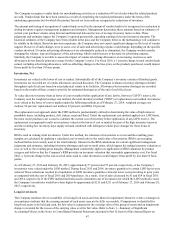Albertsons 2016 Annual Report Download - page 49
Download and view the complete annual report
Please find page 49 of the 2016 Albertsons annual report below. You can navigate through the pages in the report by either clicking on the pages listed below, or by using the keyword search tool below to find specific information within the annual report.47
The Company recognizes vendor funds for merchandising activities as a reduction of Cost of sales when the related products
are sold. Vendor funds that have been earned as a result of completing the required performance under the terms of the
underlying agreements but for which the product has not yet been sold are recognized as reductions of inventory.
The amount and timing of recognition of vendor funds as well as the amount of vendor funds to be recognized as a reduction to
ending inventory requires management judgment and estimates. Management determines these amounts based on estimates of
current year purchase volume using forecast and historical data and review of average inventory turnover data. These
judgments and estimates impact the Company’s reported gross profit, operating earnings (loss) and inventory amounts. The
historical estimates of the Company have been reliable in the past, and the Company believes the methodology will continue to
be reliable in the future. Based on previous experience, the Company does not expect significant changes in the level of vendor
support. However, if such changes were to occur, cost of sales and advertising expense could change, depending on the specific
vendors involved. If vendor advertising allowances were substantially reduced or eliminated, the Company would consider
changing the volume, type and frequency of the advertising, which could increase or decrease its advertising expense.
Similarly, the Company is not able to assess the impact of vendor advertising allowances on increasing revenues as such
allowances do not directly generate revenue for the Company’s stores. For fiscal 2016, a 1 percent change in total vendor funds
earned, including advertising allowances, with no offsetting changes to the base price on the products purchased, would impact
Gross profit by less than 10 basis points.
Inventories, Net
Inventories are valued at the lower of cost or market. Substantially all of the Company’s inventory consists of finished goods.
Inventories are recorded net of vendor allowances and cash discounts. The Company evaluates inventory shortages (shrink)
throughout each fiscal year based on actual physical counts in its facilities. Allowances for inventory shortages are recorded
based on the results of these counts to provide for estimated shortages as of the end of each fiscal year.
To value discrete inventory items at lower of cost or market before application of any last-in, first-out (“LIFO”) reserve, the
Company uses the weighted average cost method, the retail inventory method (“RIM”) or replacement cost method. Inventories
were valued at the lower of cost or market under the following methods as of February 27, 2016: weighted average cost
method, 56 percent; replacement cost method, 22 percent; and RIM, 22 percent.
The replacement cost approach under the FIFO method is predominantly utilized in determining the value of high turnover
perishable items, including produce, deli, bakery, meat and floral. Under the replacement cost method applied on a LIFO basis,
the most recent purchase cost is used to calculate the current cost of inventory before application of any LIFO reserve. The
replacement cost approach results in inventories valued at the lower of cost or market because of the high inventory turnover
and the resulting low inventory days supply on hand combined with infrequent vendor price changes for these items of
inventory.
RIM is used in valuing retail inventories. Under this method, the valuation of inventories is at cost and the resulting gross
margins are calculated by applying a calculated cost-to-retail ratio to the retail value of inventories. RIM is an averaging
method that has been widely used in the retail industry. Inherent in the RIM calculations are certain significant management
judgments and estimates, including inventory shortages and cost-to-retail ratios, which impact the ending inventory valuation at
cost, as well as the resulting gross margins. Management consistently applies its application of RIM valuations by product
category and believes that the Company’s RIM provides an inventory valuation that reasonably approximates cost. For fiscal
2016, a 1 percent change in the cost-to-retail ratios used to value inventories would impact Gross profit by less than 10 basis
points.
As of February 27, 2016 and February 28, 2015, approximately 57 percent and 55 percent, respectively, of the Company’s
inventories were valued under the LIFO method. During fiscal 2015 and 2014, inventory quantities in certain LIFO layers were
reduced. These reductions resulted in a liquidation of LIFO inventory quantities carried at lower costs prevailing in prior years
as compared with the cost of fiscal 2015 and 2014 purchases. As a result, Cost of sales decreased by $1 and $14 in fiscal 2015
and 2014, respectively. If the FIFO method had been used to determine cost of inventories for which the LIFO method is used,
the Company’s inventories would have been higher by approximately $215 and $211 as of February 27, 2016 and February 28,
2015, respectively.
Long-Lived Assets
The Company monitors the recoverability of its long-lived assets and tests them for impairment whenever events or changes in
circumstances indicate that the carrying amount of such assets may not be fully recoverable. If impairment is identified for
long-lived assets to be held and used, the fair value is compared to the carrying value of the group of assets and an impairment
charge is recorded for the excess of the carrying value over the fair value. Refer to Note 1—Summary of Significant
Accounting Policies in the Notes to Consolidated Financial Statements included in Part II, Item 8 of this Annual Report on
























